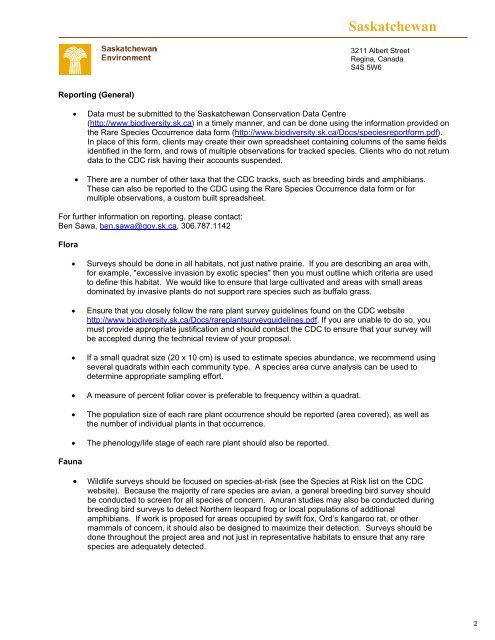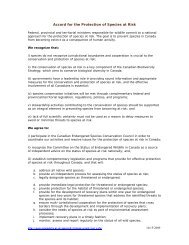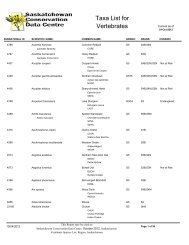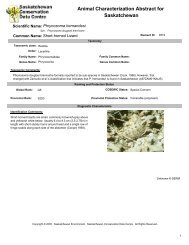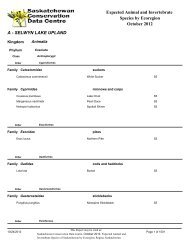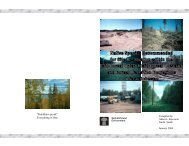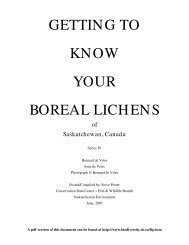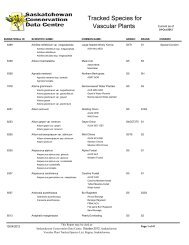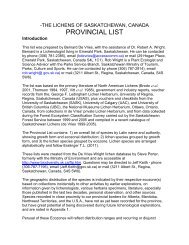Terrestrial Field Surveys - Saskatchewan Conservation Data Centre
Terrestrial Field Surveys - Saskatchewan Conservation Data Centre
Terrestrial Field Surveys - Saskatchewan Conservation Data Centre
You also want an ePaper? Increase the reach of your titles
YUMPU automatically turns print PDFs into web optimized ePapers that Google loves.
Reporting (General)<br />
<strong>Saskatchewan</strong><br />
3211 Albert Street<br />
Regina, Canada<br />
S4S 5W6<br />
<strong>Data</strong> must be submitted to the <strong>Saskatchewan</strong> <strong>Conservation</strong> <strong>Data</strong> <strong>Centre</strong><br />
(http://www.biodiversity.sk.ca) in a timely manner, and can be done using the information provided on<br />
the Rare Species Occurrence data form (http://www.biodiversity.sk.ca/Docs/speciesreportform.pdf).<br />
In place of this form, clients may create their own spreadsheet containing columns of the same fields<br />
identified in the form, and rows of multiple observations for tracked species. Clients who do not return<br />
data to the CDC risk having their accounts suspended.<br />
There are a number of other taxa that the CDC tracks, such as breeding birds and amphibians.<br />
These can also be reported to the CDC using the Rare Species Occurrence data form or for<br />
multiple observations, a custom built spreadsheet.<br />
For further information on reporting, please contact:<br />
Ben Sawa, ben.sawa@gov.sk.ca, 306.787.1142<br />
Flora<br />
Fauna<br />
<strong>Surveys</strong> should be done in all habitats, not just native prairie. If you are describing an area with,<br />
for example, "excessive invasion by exotic species" then you must outline which criteria are used<br />
to define this habitat. We would like to ensure that large cultivated and areas with small areas<br />
dominated by invasive plants do not support rare species such as buffalo grass.<br />
Ensure that you closely follow the rare plant survey guidelines found on the CDC website<br />
http://www.biodiversity.sk.ca/Docs/rareplantsurveyguidelines.pdf. If you are unable to do so, you<br />
must provide appropriate justification and should contact the CDC to ensure that your survey will<br />
be accepted during the technical review of your proposal.<br />
If a small quadrat size (20 x 10 cm) is used to estimate species abundance, we recommend using<br />
several quadrats within each community type. A species area curve analysis can be used to<br />
determine appropriate sampling effort.<br />
A measure of percent foliar cover is preferable to frequency within a quadrat.<br />
The population size of each rare plant occurrence should be reported (area covered), as well as<br />
the number of individual plants in that occurrence.<br />
The phenology/life stage of each rare plant should also be reported.<br />
Wildlife surveys should be focused on species-at-risk (see the Species at Risk list on the CDC<br />
website). Because the majority of rare species are avian, a general breeding bird survey should<br />
be conducted to screen for all species of concern. Anuran studies may also be conducted during<br />
breeding bird surveys to detect Northern leopard frog or local populations of additional<br />
amphibians. If work is proposed for areas occupied by swift fox, Ord’s kangaroo rat, or other<br />
mammals of concern, it should also be designed to maximize their detection. <strong>Surveys</strong> should be<br />
done throughout the project area and not just in representative habitats to ensure that any rare<br />
species are adequately detected.<br />
2


